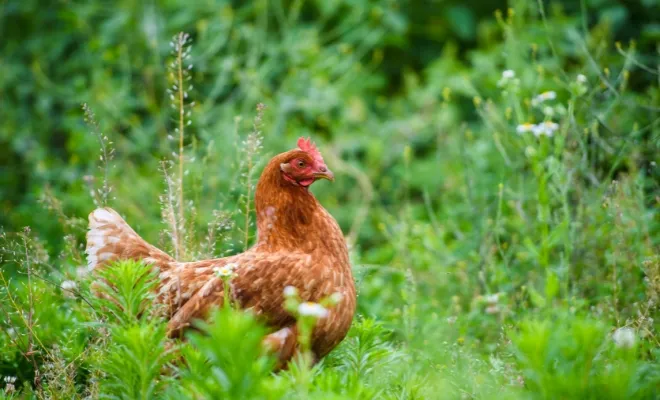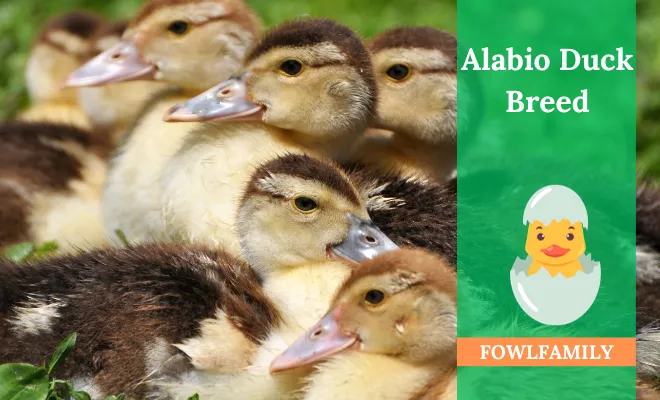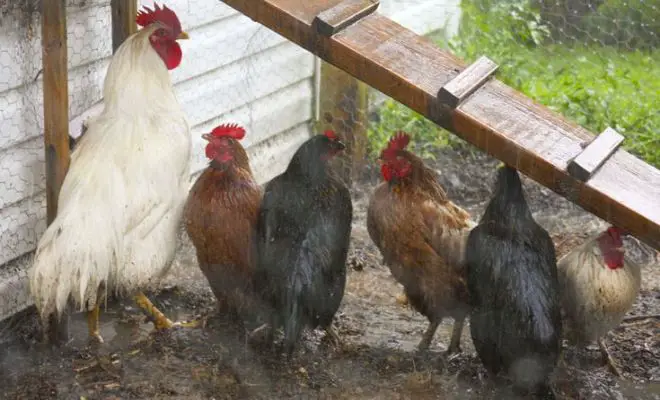Guide to Raising Cinnamon Queen Chicken Breed
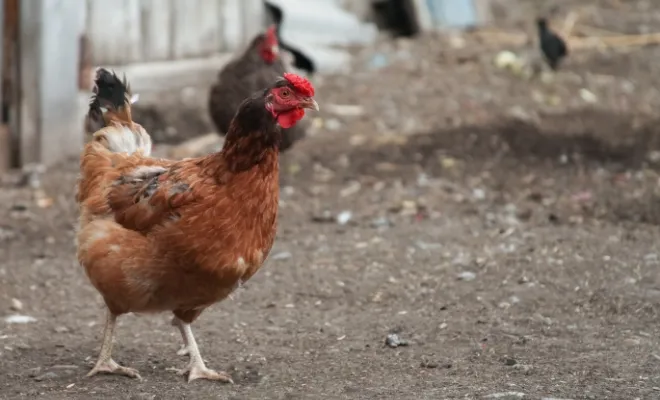
The Cinnamon Queen Chicken Breed is a wonderful addition to backyard flocks. It’s a new breed, a mix of Rhode Island Reds and Silver Laced Wyandottes, winning the hearts of chicken enthusiasts.
What makes the Cinnamon Queen special? It lays a lot of large, brown eggs consistently. Besides being an excellent egg layer, they showcase a friendly and docile temperament. So, you can make them a suitable addition to family farms or backyard flocks.
The Cinnamon Queen is versatile as they’re good for egg and meat and adds charm to any flock. Let’s explore this beneficial chicken breed more.
Table of Contents
Cinnamon Queen Chicken Breed Profile
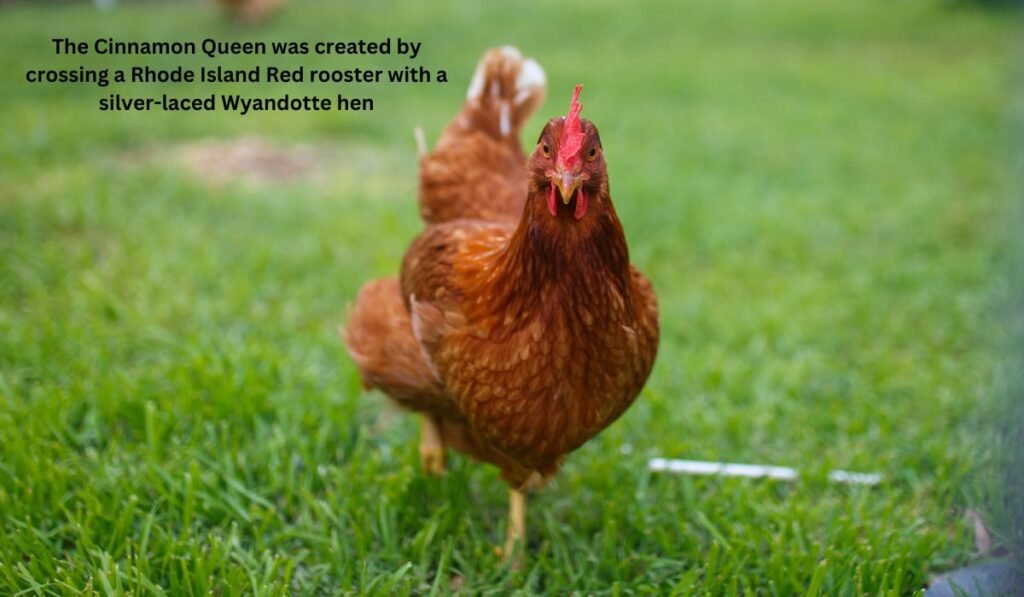
Here is a short profile that you can check about Cinnamon Queen chickens –
| Trait | Description |
|---|---|
| Origin | United States |
| Year Developed | Mid-20th Century |
| Parent Breeds | Rhode Island Red & Silver Laced Wyandotte |
| Color | Deep Cinnamon Brown with Black Speckling |
| Comb Type | Single |
| Earlobes | Red |
| Size | Medium |
| Weight (Rooster) | 7-9 lbs |
| Weight (Hen) | 5-7 lbs |
| Temperament | Docile, Friendly |
| Climate Tolerance | Hardy, Adaptable to Different Climates |
| Egg Laying Ability | Excellent, 4-5+ Eggs per Week |
| Egg Color | Light Brown with Dark Spots |
| Egg Size | Large |
| Meat Production | Decent, Suitable for Dual-Purpose Use |
History And Location Of Cinnamon Queen Chicken Breed
The Cinnamon Queen breed doesn’t boast a long or storied history like some older chicken breeds. Its origins are relatively recent and precise:
Origin: United States
Time Period: Mid-20th Century
Crossbreed: The Cinnamon Queen was created by crossing a Rhode Island Red rooster with a silver-laced Wyandotte hen.
Location: The exact location of its creation isn’t pinpointed. However, the breeds involved originate from New England (Rhode Island Red) and Pennsylvania (Silver-Laced Wyandotte).
Therefore, the Cinnamon Queen is considered a relatively new American breed. We consider them born from the skillful combination of two established breeds in the mid-20th century.
Note: So it’s likely the Cinnamon Queen emerged somewhere in the northeastern United States.
Physical Appearance of Cinnamon Queen Chicken Breed
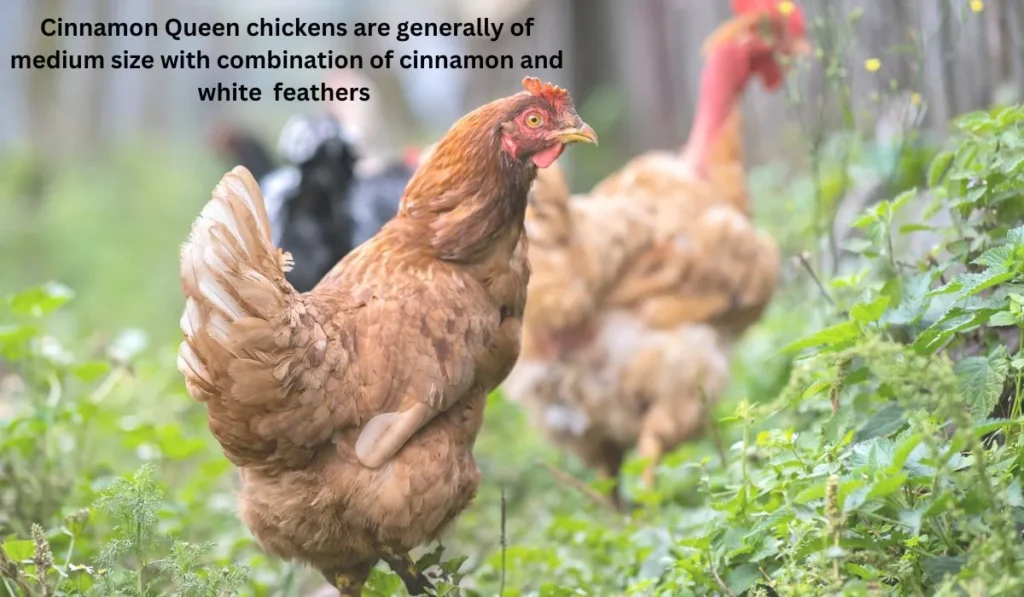
If you are new to know about Cinnamon Queen chickens, here are the details about their appearance. Hope it may help you recognize them well.
Size
Cinnamon Queen chickens are generally of medium size, making them versatile for various backyard settings. While adult hens tend to be slightly smaller than roosters, both exhibit a well-proportioned size that contributes to their overall graceful presence.
Color
What sets Cinnamon Queens apart is their captivating coloration. Their feathers showcase a beautiful combination of cinnamon and white hues. The cinnamon tones are particularly rich and vibrant, adding to the visual appeal of these chickens.
Shape
In terms of body shape, Cinnamon Queens are well-balanced with a straight back, lending an elegant and classic appearance. Their medium build makes them adaptable to different environments, and their overall physique contributes to their overall charm.
Feathers
Cinnamon Queens boasts feathers that are not only visually appealing but also practical. The feathers are soft, smooth, and densely packed, providing effective insulation. This characteristic plumage enhances both their aesthetic appeal and resilience.
Head
The head of a Cinnamon Queen is characterized by its small size, maintaining proportionality to the body. One distinct feature is the presence of a red comb and wattles, which not only adds a touch of color but also contributes to the individuality of their overall look.
What is the Personality of the Cinnamon Queen Chicken?

They’re like the good-natured giants of the chicken world. I am saying this because they are easy to keep.
Here’s a quick rundown of their charm.
Gentle & Docile
These feathered friends are true sweethearts. They’re calm and mellow, making them perfect for kids or people who want a friendly chicken mate. Even if you pick them up for a cuddle, they won’t mind.
Curious & Independent
Don’t let their laid-back nature fool you. Cinnamon Queens are smart cookies! They love exploring their coop and yard, checking out everything with their bright, curious eyes. They’re happy to forage for their own treats and can handle free-ranging if you have the space.
Social & Easygoing
These chickens get along well with everyone, whether it’s other chickens, different breeds, or even other pets. They’re not known for being aggressive or territorial, so they’re a great addition to a mixed flock.
Quiet & Low-Maintenance
Unlike some rowdy roosters, Cinnamon Queens are relatively quiet birds. They won’t wake you up at the crack of dawn with loud crowing, making them suitable for urban areas or anyone who appreciates a bit of peace and quiet.
Reproduction And Breeding Of Cinnamon Queen Chicken Breed
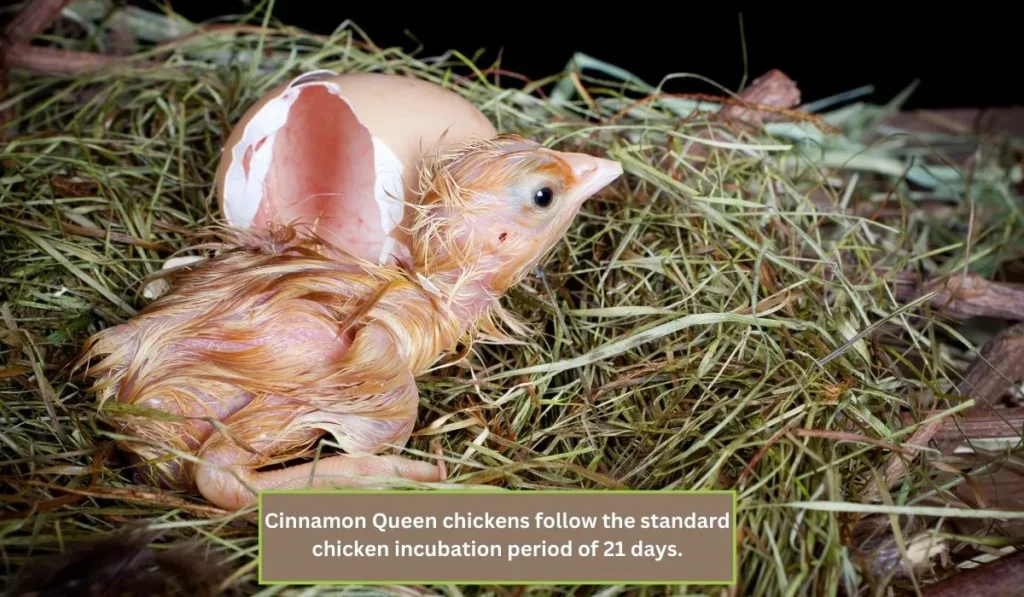
The reproduction and breeding of the Cinnamon Queen breed is not challenging. Rather, it’s suitable for beginners and experienced poultry keepers. Read to know from A to Z about such breeds!
How long does it take for a Cinnamon Queen Chicken to hatch?
Cinnamon Queen chickens follow the standard chicken incubation period of 21 days.
The University of Minnesota confirms incubation temperature, humidity, and egg turning play crucial roles. It’s for safe hatching. It’s applicable for most chicken breeds, including the Cinnamon Queen.
How To Breed Cinnamon Queen Chicken? 9 Steps to Follow!
It’s important to do it right to ensure healthy chicks and a successful flock. Here’s a step-by-step guide to breeding Cinnamon Queens:
Choose your breeders
Select healthy, mature chickens (over 6 months old) with good egg production and desirable traits. Both the rooster and hens should be purebred Cinnamon Queens.
Prepare the breeding pen
Create a spacious (at least 10 square feet per bird) and secure enclosure with nesting boxes, perches, feeders, and waterers. Ensure good ventilation and protection from predators.
Introduce the birds
Gradually introduce the rooster to the hens. Ensure you notice any signs of aggression and separate them. Ideally, introduce a new rooster to a group of hens already familiar with each other.
Maintain the right ratio
Aim for a ratio of one rooster to 4-8 hens for optimal mating. This ensures all hens have a chance to mate and reduces stress on the rooster.
Provide nesting boxes
Offer plenty of clean, private nesting boxes (one per 3-4 hens) filled with soft bedding to encourage laying and incubation.
Monitor the mating process
Observe the flock for signs of mating, such as the rooster mounting the hens. This usually happens in the morning and afternoon.
Collect fertile eggs
Gather eggs daily and store them in a cool, humid place (around 55°F and 70% humidity) until ready for setting.
Set the incubator
Set your incubator to the correct temperature (99.5°F) and humidity (50-60%). Turn the eggs regularly according to the manufacturer’s instructions.
According to NCBI, maintain an incubation temperature between 37 and 38°C (usually 37.5–37.8°C). It maximizes the likelihood of successful hatching.
Monitor the incubation process
Check the eggs periodically for signs of development using a candler. But what to monitor? Here are the things that you should check –
- Ensure the incubator is clean and properly calibrated.
- Gently place the Cinnamon Queen eggs in the incubator,. It ensures they are positioned with the pointed end down.
- Regularly check and maintain a consistent temperature within the incubator.
- Eggs should be turned regularly, at least three times a day, until day 18 of incubation.
- Around day 7, use a candling device to inspect the eggs.
- Watch for pipping – small cracks in the eggshell made by the chicks.
- Once the chicks hatch, move them to a brooder with appropriate heat and bedding.
- Keep a record of the incubation process.
Welcome the chicks
After 21 days, your adorable Cinnamon Queen chicks will hatch! Provide them with warmth, food, and water in a separate brooder pen.
How Many Eggs Do Cinnamon Queen Chicken Lay?
Cinnamon Queen hens are celebrated for their impressive egg production. They consistently deliver 4-5 eggs per week on average. This translates to over 200 eggs annually.
Here’s a breakdown of their laying prowess.
- Average Clutch Size: 4-5 eggs per week
- Annual Production: Over 200 eggs per year
- Egg Color: Light brown with dark spots
- Egg Size: Large
Which Color Eggs Do Cinnamon Queen Chicken Lay?
Cinnamon Queen hens lay lovely light brown eggs with dark spots. The exact shade may vary based on factors like diet and genetics.
What Purpose Does Cinnamon Queen Chicken Breed Serve the Best for?
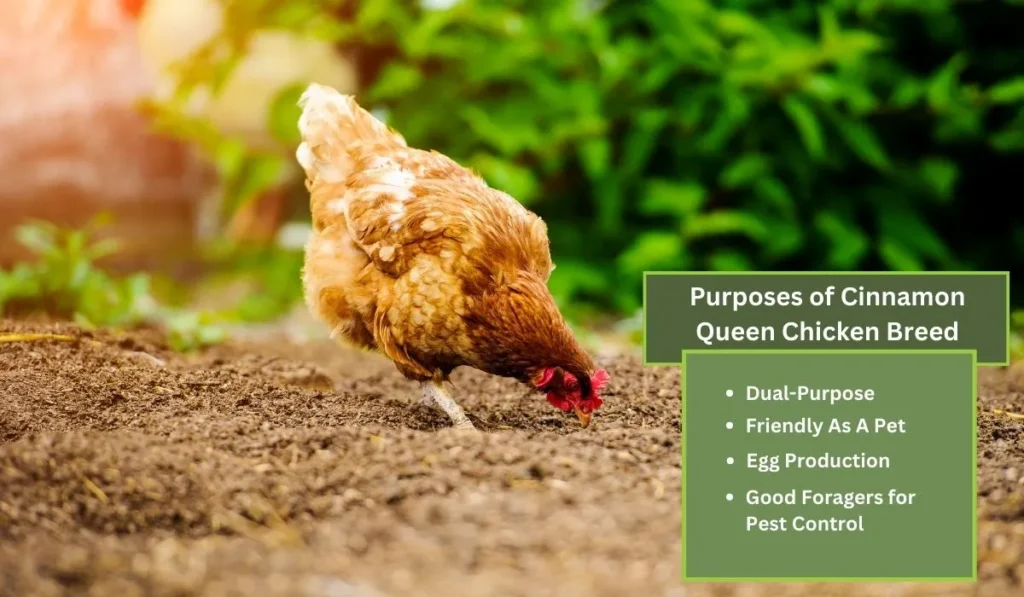
The Cinnamon Queen shines in several ways. But when it comes to purpose, they truly excel in purposes such as:
Dual-Purpose
While not bred primarily for meat, Cinnamon Queens are an option for occasional homegrown chicken dinners. Roosters typically reach 7-9 pounds, and hens 5-7 pounds. Most importantly, they provide tasty, homegrown meat.
They thrive in various climates, from hot summers to cold winters. It’s what makes them suitable for a wider range of locations.
Friendly As A Pet
Unlike some rowdy roosters, Cinnamon Queens are known for their calm and friendly nature. This makes them suitable for families with children or anyone who wants a docile and manageable flock.
So, they’re quiet birds, making them suitable for urban areas.
Egg Production
These cinnamon-colored hens lay an impressive 4-5 eggs per week on average and over 200 eggs annually. That’s a steady supply of delicious, fresh eggs for your family or kitchen creations.
Note: They lay consistently throughout the year, except for a natural dip during short winter days.
Recommended Readings
- Brown Leghorn Egg Laying Chicken Breed
- The Cochin Chicken Breed
- Blue-Laced Golden Wyandotte Chicken
- About Amberlink Chicken Breed
Good Foragers for Pest Control
They love exploring their yard and readily find their own treats. So, it sometimes reduces feed costs as well as controls the pests in the garden.
How To Raise Cinnamon Queen Chicken Breed?
Raising Cinnamon Queen chickens is a rewarding experience, but it requires planning and preparation. Here’s a guide to get you started:
Proper Housing
Provide a spacious coop (4-8 square feet per bird). It must include good ventilation, secured wire mesh, and protection from predators and weather. Also, add perches, nesting boxes (one per 3-4 hens), feeders, and waterers.
Give them access to a spacious outdoor run (at least 10 square feet per bird) with fencing. It’s for predators’ vulnerability. Be vigilant against predators like foxes, hawks, and raccoons. Consider secure runs, fencing, and predator deterrents.
Besides, consider grass or dirt for dust bathing and scratching.
Properly Feeding
Offer chicks a high-protein chick starter feed (20-24% protein) for the first 8 weeks. Then, Switch to a grower feed (16-18% protein) from 8 to 18 weeks.
When they become an adult hens, a balanced laying feed (16-18% protein) is crucial. But ensure they have calcium to support egg production.
You can also offer grit for digestion and fresh water access at all times.
Care for Them
Maintain a clean coop by regularly removing droppings and changing bedding. Sanitize the coop periodically to prevent disease.
Check your chickens for signs of injury or illness. Seek veterinary advice if needed. Provide vaccinations recommended for your area.
See the video for more knowledge about the beautiful Cinnamon Queen Chickens.
Pros And Cons of Having Cinnamon Queen Chicken Breed
Here is a breakdown of the pros and cons of getting the Cinnamon Queen chickens in the backyard.
Pros:
- They are prolific Egg Layers.
- While bred primarily for eggs, they offer decent meat at maturity.
- They have stunning cinnamon plumage with black speckles. So, the coop will look more eye-catchy!
- From hot summers to cold winters, they are suitable for a wider range of locations.
- Calm and friendly nature makes them suitable for families with children.
- They are good foragers so the diet cost becomes less.
- Ideal chicken breed for urban areas.
- They take good care of their chicks.
Cons:
- They are a relatively new breed.
- While beautiful, their feathering sometimes shows minor variations. So, they are not ideal for competitive showmanship.
- Their popularity and desirable traits make them more expensive than some common breeds.
- Not specifically bred for meat, they yield less than chickens dedicated to meat production.
- Their unique needs can make it challenging to keep for beginners.
Related Readings:
- Buff Brahmas Chicken Breed
- The Classic Black Copper Maran Chicken Breed
- Isa Brown Chicken Breed As A Perfect Poultry
Final Word
So, the hybrid Cinnamon Queen Chicken Breed has amazing traits. This is because of Rhode Island Reds and Silver Laced Wyandottes breed. With its unique cinnamon plumage, friendly nature, and dual-purpose qualities, it appeals to both new and seasoned poultry keepers.
Whether enhancing backyard flocks or farming with abundant egg laying and quality meat, the Cinnamon Queens are great. Still being a new breed, they already got popularity and demand in the poultry world.


